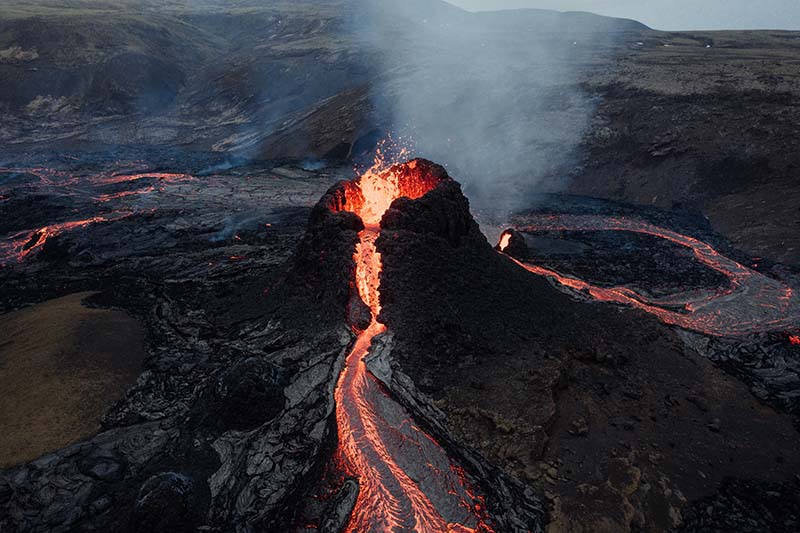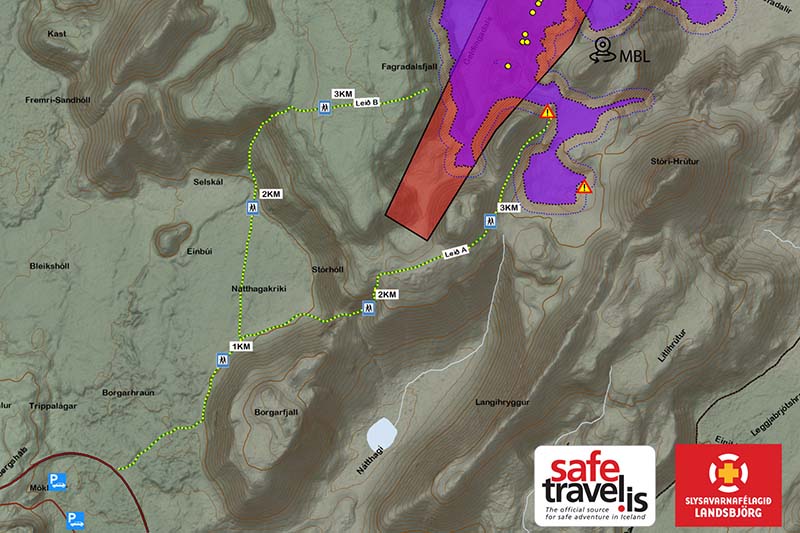This blog post was written in 2021 and some parts might be outdated. If you are looking for information about the 2022 eruption, check out this blog post.
The Fagradalsfjall volcano is the newest and hottest (literally) attraction in Iceland. It already has many names – Fagradalsfjall, Geldingadalir, Meradalir. They all refer to different valleys and mountains where the fissures have opened up. However, don’t worry too much if you can’t pronounce these names. Pretty much everybody in the country refers to it as THE volcano. The eruption started on 19th March and hasn’t stopped yet. Located in Reykjanes peninsula, only 30 km away from Reykjavik, it became a popular destination for day trips. Soon after the eruption started, hiking trails were marked to guide those who want to observe the eruption up close. However, there are a few things to keep in mind before you start the journey.

Opening Hours
The weather in Iceland is unpredictable, and the hike towards the volcano is not the easiest one. Firstly, check if the eruption site is open. I know – you wonder how come a volcano has opening hours? It refers to time slots when police and/or rescue team are on duty in the area to ensure everybody’s safety. Some days it is forbidden to visit the volcano due to extreme weather or high toxic gas concentration in the area.
During the eruption, the volcano spews out not only hot magma but also toxic gas. The concentration of gas is closely monitored, and people are being evacuated if it gets dangerous. However, you cannot see or smell poisonous gas. If you start feeling any discomfort (headache, dizziness, nausea), leave the area immediately. Another safety hazard is the area itself. The eruption is still in full swing, with more fissures opening up. Therefore, it is recommended to stay on hills and ridges and avoid low-lying areas.
The up-to-date information can be found on the Icelandic Association for Search and Rescue (ICE-SAR) website safetravel.is. Do not go there if it is closed. Not only will you put yourself in great danger, but also you will put the ICE-SAR rescue team in danger if things will take a turn for the worse, and you will need their assistance.

Dress for Success
It is crucial to dress accordingly and bring the right gear. Even if it looks warm and sunny outside, make sure you layer up with some warm clothes, windproof and waterproof outerwear, good hiking shoes, gloves, and a hat. Need tips on what to put in your suitcase before coming to Iceland? We’ve got you covered.
If you are pretty fit, expect 3-4 hours to walk there and back again. There are no facilities (yet). Make sure to have some food with you and plenty of water. Before you hit the road, here are some equipment that you might want to consider taking with you:
- Fully charged phone and a power bank. The area has an abysmal phone connection, and it might be difficult to call for help if you get lost. Nevertheless, I managed to call my mom and say hello from the volcano’s foot when I visited. It was fun!
- Crampons. The day I went there, it was snowing in the morning, and while it was sunny during the hike, there were patches of ice throughout the trail. Upon arrival, ICE-SAR recommended using crampons for safety.
- Headlamp and extra batteries. The days are getting longer, but we still get some nighttime darkness here in Iceland, and many people want to see the volcano at night. In that case, make sure to bring a headlamp. The terrain is rough and difficult during the day. It is easy to slip and injure yourself, but it gets even more dangerous if you walk in the dark and can’t clearly see where you are stepping.
- Hiking poles. The trail’s start is a flat gravel path, but don’t let it fool you. Soon it turns into rugged lava fields, and you have to climb up steep hills (the elevation gain is approx. 250 m). Hiking poles can provide great support on the hike.
- Mask. With the low number of new COVID-19 cases, Iceland is a relatively safe travel destination. However, on a good day, the Fagradasfjall volcano attracts hundreds of people. With so many curious observers hiking up and down narrow trails, it can be hard to maintain a 2-meter-rule. Therefore, we recommend wearing a mask (bring some hand sanitizer as well).

Avoid Putting Yourself in Dangerous Situations
Quite a few resources are being used to ensure the highest level of safety at the eruption site. Unfortunately, this is not a man-made touristy attraction, and nature doesn’t care about safety standards. It does what it wants to do. Meanwhile, as humans, we are only tiny spectators, so if you decided to visit the volcano, proceed with caution. Among all of the gear listed above, don’t leave your common sense at home. Here are a few examples:
- Don’t visit the volcano if you are in quarantine. Once you arrive in the country, you need to follow all of the safety protocols. Travelling is prohibited if you are in quarantine or waiting for the test results.
- Don’t try to walk on lava. With a naked eye, some parts of the new lava field may look hardened and stone-like. However, lava still flows underneath, and fresh hot lava puddles can form at any time. Keep a safe distance at all times.
- Don’t litter. Whatever trash you may accumulate during the trip – keep it until you find a trash can. Respect nature and leave the area the way you found it.
- Help others that might be in trouble. People have gotten injured, got lost, experienced hypothermia, toxic gas poisoning. If you see somebody that might need any help, don’t just walk past them.

How to Get There
The start of the walk is on the road 427, 10 min drive east of Grindavík. It is forbidden to leave cars on the road’s shoulder, but there is a parking space 1 km east of the hiking trail.
Most importantly – have fun, stay safe and enjoy this unique opportunity to visit Icelandic Mordor.
UPDATED 19th March: From 19th March, visitors have to pay for the parking next to the hiking path. It costs 1000 ISK per car. To pay for the parking visit Parka.is
Back